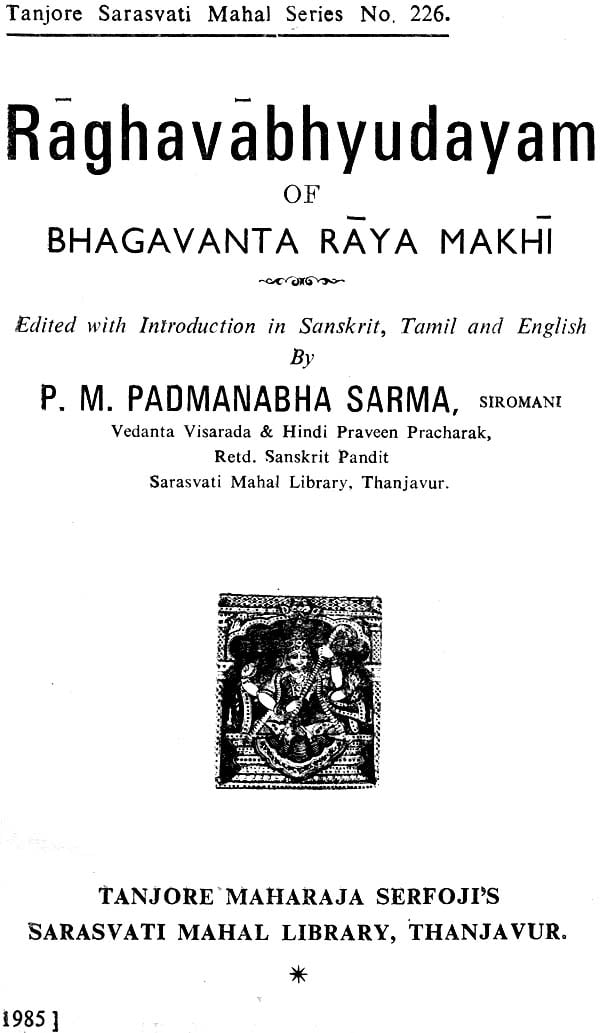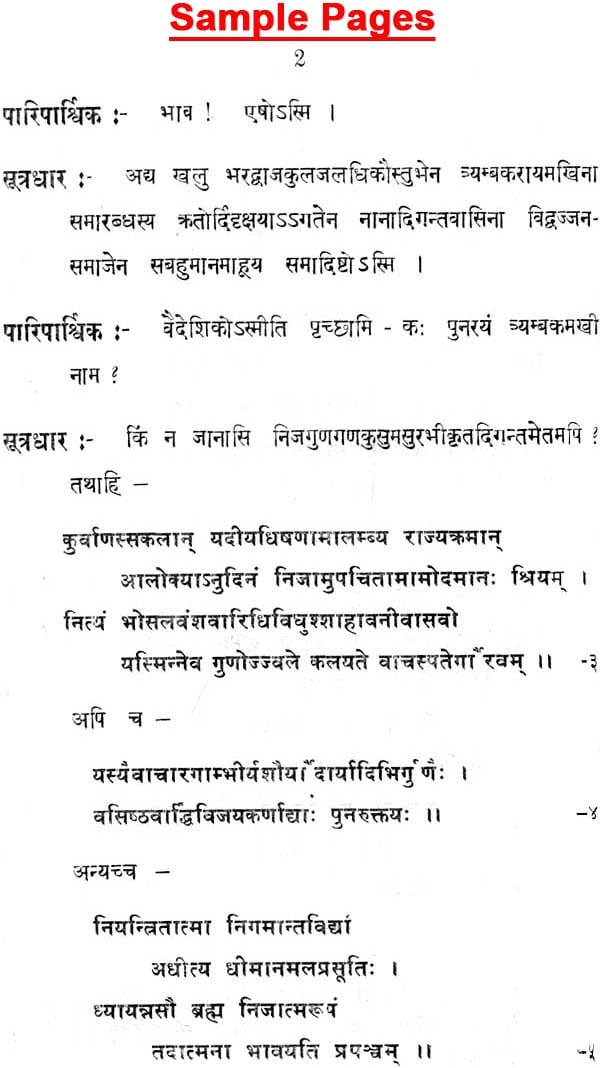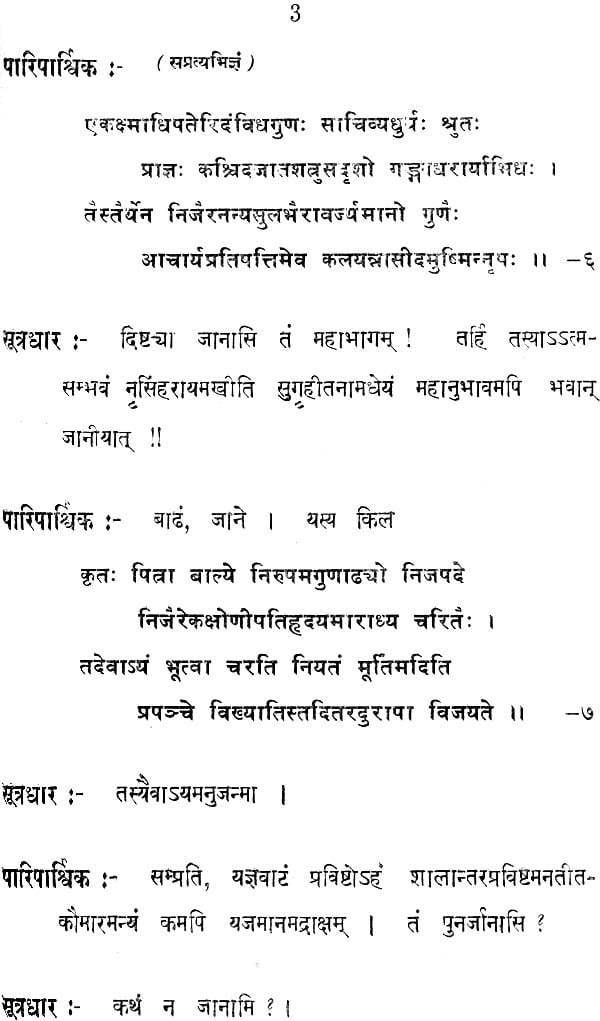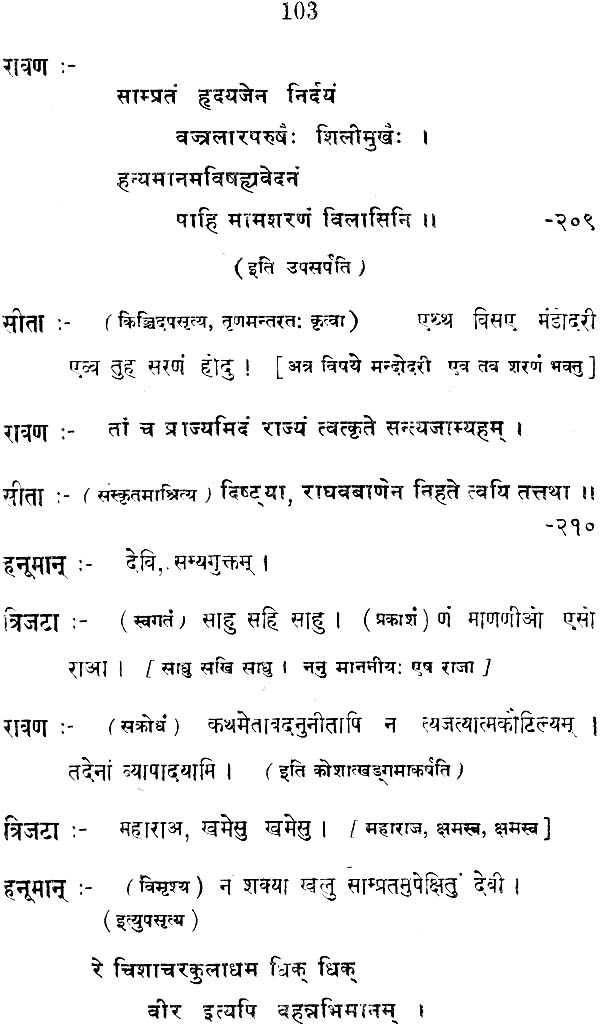
श्रीराघवाभ्युदयम्: Sri Raghavabhyudayam of Bhagavanta Raya Makhi (An Old and Rare Book)
Book Specification
| Item Code: | NZJ560 |
| Author: | P. M. Padmanabha Sarma |
| Publisher: | SARASVATI MAHAL LIBRARY & RESEARCH CENTRE |
| Language: | Sanskrit Only |
| Edition: | 1985 |
| Pages: | 200 |
| Cover: | Paperback |
| Other Details | 8.5 inch X 5.5 inch |
| Weight | 190 gm |
Book Description

Like the various literatures that carne into being in Tamil in the literary forms prose, poetry and drama we also have in Sanskrit different literatures in the forms GADHYAM, PADHYAM, CHAMPU and DRAMA. Amongst them drama became a popular art form both with the lettered and the unlettered. RAGHAV ABYUDHAYAM is one such play that became very popular. Though its source material is THE RAMAYANA it largely relies on imagination suiting the emotive states.
From time immemorial Thanjavur has enjoyed a unique glory and historical importance. The Big Temple built by Rajaraja Chola, the magnificent palace of the Nayakka kings and the Saraswathi Mahal Library which is an off shoot of Maratta Renaissance - all remain as historical evidences and symbols of our art and culture which have an international reputation.
The river Ponni also known as Cauvery girdles the Chola kingdom making it the granary of South India. The fertility of the soil is equally matched by its fertile culture and the growth of art and literature. On the banks of Cauvery innumerable poets, scholars and pandits flourished and the rulers of the kingdom invited scholars from the North and patronised them.
From 1676 A. D. to 1855 A. D. ten Maratta Kings ruled over Thanjavur for a period of 179 years. The first among them was Ekoji or Venkoji who ruled from 1376 to 1683. It was in his court that the father of the author of this play served as a minister.
Baghawantharaya mahi is the author of this play and his father Gangadhara mahi the minister, was a profound scholar in the Vedas and the Sastras. He belings to the Bharadwaja Gothra and his three worthy sons were Narasimharaya mahi, Triyambakaraya mahi and Baghawantaraya mahi. It is evident from the suffix ‘mahi’ that they were not only well versed in the Vedas and the Sastras but also performed the yagas like the Somayaga as ordained in the Vedas. There are also evidences to this effect. A few years later Gangadhara mahi retired from active service after making his son Narasimharayamahi the minister to king Ekoji. Like his father Narasimharaya mahi also discharged his duties and endeared himself to the king.
After Ekoji Shahaji II ruled over Thanjavur from 1684-1711. By birth he was a poet and a musician. It is no exaggeration to say that he had competence in many languages and the scholars of his era called him ‘Abinava Bhoja.’ Triyambakaraya mahi, the second son of Gangadhara mahi became a minister in the court of this ruler. He too was interested in spiritual pursuits besides the material, and retired from service after making Anandaraya mahi, the son of his brother Narasimharaya mahi who was still a boy, a minister to King Shahaji. The author of this book, Baghawantharaya mahi, though not a minister to any king earned through his scholarship a reputation what his brothers earned through the office of a minister and shone as a brilliant star in the literary firmament. The details given above are all stated by the author in his preface to his play.
Though man can attain eternal bliss in various ways it is easier to attain it through a study of the Epics and Dramas. As a literary form drama is superior to the Epic because of its ability to attract and to have an immediate impact on the common man. That explains why the great writers exploited this art form to convey in a simple way the abstract and the complex. Drama as a literary form has the power to appeal to the heart through the senses and explain difficult concepts in an easy way.
There is an ancient Sanskrit saying that ‘Drama is the touchstone of a great poet.’ Our PURANAS, ALANKARA SASTRAS and BHARATA SASTRA reaffirm this view point. Again scholars like Baghavantharaya mahi though proficient in the Vedas and pursued the Vedic Marga through performing yagas, recognised the importance of drama as an art form and wrote many plays. RAGHAVABYUDHAM is one such play written by Baghavantharaya mahi.
In Sanskrit Literature rules have been laid down for the structure of a play the traits of a hero the qualities of a heroine, the number of Acts, the dominant motif, characterisation permissible descriptions the style of the dialogue the rhythm of the slokas etc. Following the great tradition of keeping THE RAMAYANA and THE MAHABHARATHA as the nucleus it has become customary to write plays centred around the characters of these epics. For example, Bhasan, Bhavabhuthi, Murari. Raja sekharan, Ramabadhra Dikshit, Chudamani Dikshit, Jayadeva, Sakthibadhra are one of the poets who have successfully exploited the story material of THE RAMAYANA, the reason being that Rama was a perfect hero and Sita a perfect, heroine. Following this tradition Baghavantharaya mahi has written the play Raghavabyudhayam with the Ramayana story as it nucleus.
Valmiki’s RAMAYANA is an epic of renoun. Hence the dramatist handles the theme in a different way by abandoning the traditional way of story telling and seeks to alter the progression of events to suit the varying emotive states. This could be seen in the synopsis of the play.
The author, born in BHARADWAJA GOTHRA has to his credit a poem Mukhnuda Vilasam and a Champu Kavya entitled “Uttara Champu”. I had the privilege of publishing the Champu Kavya in the journal of the Library. Now I consider myself singularly fortunate to be able to publish this play.
There is only one palm leaf script of this play extant in this library. This could be easily understood only if the author stands by and interprets. This play could not be understood for a long time because of the lack of Sanskrit equivalents for the Prakruta script in which the dialogues are written. That explains why the play was not published all these years.
I hope the reading public will easily understand the play now that the Prakrit dialogues have been set in sanskrit equivalents.
I am deeply indebted to the authorities of the library who have entrusted me with this work, in particular to Sri T. R. Ramaswamy. I. A. S. Collector of Thanjavur District and to Sri A. Panchanathan, M. A., B. Lib. Sc., the Administrative Officer i/c who gave me all support and help. I am also thankful to the printers for their neat execution and their co-operation in bringing out an error-free edition. I appeal to the reading public to enjoy reading this play and I crave their pardon U errors have crept in unwittingly.
| Publisher's Preface | i-ii |
| English Introduction | i-v |
| Tamil Introduction | vii-xii |
| Sanskrit Introduction | xiii-xxii |
| katha Sangrahah | xxiii-xxxviii |
| Cast of Characters | xxxix-xl |
| Text of the Play | |
| Ist Anka | 1-18 |
| IInd Anka | 18-35 |
| IIIrd Anka | 35-57 |
| IVth Anka | 57-73 |
| Vth Anka | 73-108 |
| VIth Anka | 108-127 |
| VIIth Anka | 127-140 |
| Idex of Slokas | 141-154 |









